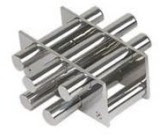Attractive
transition is a quantifiable amount of an attractive field over a given region.
Transition lines are frequently used to portray the course of motion as it
streams from the north toward the south pole of a Magnetic chuck. The more
prominent number of these motion lines the more noteworthy the thickness of the
motion and eventually, the more noteworthy the attractive power.
By
and large, attractive transition will take the simplest course from one post to
another. Air-holes are utilized in plans and applications to urge attractive
motion to take a specific course that would help the holding of the workpiece
or burden.
The
utilization of air-holes and post pieces permits the focal point of the
attractive transition where it is best and simultaneously, eliminates or lessen
motion from regions where it might turn into a disturbance.
Makers
of attractive hurls and attractive lifters plan their items for a scope of
utilizations. The genuine exhibition of the item can change contingent upon how
they are applied.
All
clients of these items should comprehend that the magnetic
welding holder is an essential piece of the general circuit and
attractive transition will act contrastingly with different workpieces and how
they are situated over the shafts.
As
expressed before, stray attractive transition won't just impede cut execution
but on the other hand is proof of wasteful attractive power.
The
objective for any attractive workholder is the place where the attractive
motion radiating from the shafts is completely assimilated inside the
workpiece.
A
workpiece that is too slender cannot retain all the attractive motion made
accessible by the throw shafts. Furthermore, this failure causes the thickness
of the transition at the post/workpiece connection point to diminish which will
influence cinch force.
A
workpiece can have a lopsidedness of the post regions. Likewise, the motion
isn't valuable and contributes very little to holding force. Furthermore a
portion of the wanderer motion will utilize the Magnetic
chuck and potentially the slicing apparatus to track down an elective
course. Just sliding the workpiece to the right region would further develop
holding force and limit stray transition.



